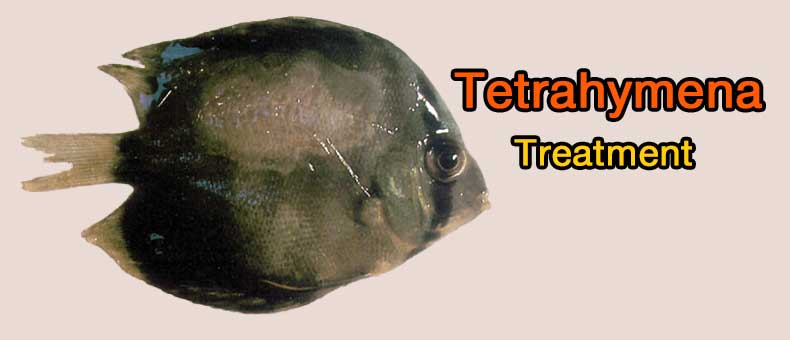
Tetrahymena (Corlissi) is a free-living protozoan that causes the death of apparently large numbers of fishes and other organisms in hatcheries and aquariums worldwide. This disease occurs when both the protozoans and fishes’ population are at a higher level of concentration.
Table of Contents
Symptoms of Tetrahymena
There are many symptoms that fishes or affected organisms show when attacked by Tetrahymena:
The Tetrahymena symptoms can be present in various appearances:
- Just like most skin protozoans, it produces flecks of slime on fish.
- Tetrahymena also usually affects the eye and causes a white and pop-eye.
- Tetrahymena can also be seen as white spots somehow like ich in appearance.
- Several times, Tetrahymena infests fishes’ outer tissues and causes them to have a translucent white patch with their scales raised. These patches usually occur on these fishes’ forehead above the eyes or in front of their dorsal fin.
- It can be whitish areas like chilodonella and costia or patchy gray.
Tetrahymena Causes and Description
Tetrahymena is dangerous, and it is discovered as detritus in many aquariums. They tend to occur in livebearers (such as Discus), and unlike Epistylis, Tetrahymena does not stick out in the water column from the fish.
Tetrahymena flacks a fish’s skin and then digs into the fish’s insides, most times killing it rapidly.
So, I can shortlist the causes of Tetrahymena:
[1] – Tetrahymena is always significant of water with high bacterial level and bunches of organic matter inside the water which denotes poor filtration.
[2] – The high level of bacterial in the water feeds the Tetrahymena organism, which helps it take on the fish’s immune system resources. This pronged attack is very difficult to combat by the fish.
In contrast to Ich, Tetrahymena is the cause of quick death in aquarium fishes, and it is at a very higher rate. If not well observed, some infected fish can appear to be healthy one moment and be dead in a short time.
Tetrahymena, most times, is seen in livebearers and guppies aside from Discus, the reason why it is usually referred to as the “guppy disease” or “guppy killer.”
Difference Between Tetrahymena And Ich
In the close observation of diseases that attack fishes in aquariums, the study shows some similarities between Tetrahymena and Ich.
Below are the differences between Tetrahymena And Ich:
| Tetrahymena | Ich |
| The Tetrahymena spot is gray. | Ich spots are ceiling white. |
| Tetrahymena spots can be irregular in appearance. | Ich has a rounded shape constantly. |
| Tetrahymena tends to be on a particular area at a time. | Ich is usually over the entire body of the fish. |
| Spots are more translucent. | Spots are opaque. |
| Spots seem to be in clumps. | Spots equally distributed. |
| Ich treatment doesn’t treat Tetrahymena. | Ich treatment works. |
| Tetrahymena could be fatal. | Ich is not fatal in general. |
Discus Tetrahymena Treatment
Treating most skin protozoan diseases, including Tetrahymena, can be done with a whole number of steps:
[STEP 1] Preparations & Medication
- Add lots of additional biofiltration (under-gravel, canister, or sump) to filter out and kill these free-moving organisms. This added biofiltration reduces the bacterial building up in the water, which gives the fish avenue to dedicate more immune system resources to this pathogen.
- Do not change out or clean the filter media.
- Adding a malachite medication or a Copper based medication to the aquarium will kill the free organism that is the cause of this disease.
- Do not transfer the Discus fish in the quarantine tank, rather, leave them there.
- Do not raise the temperature of the tank.
- Regularly, add a UV sterilizer to kill these free organisms and to reduce the bacterial accumulating in the water, which also, in turn, gives the fish opportunity to open up their more immune system resources to this pathogen.
- Adding aeration is always helpful. “Always”.
[STEP 2] Salt Bath
3 to 3.5% salt bath (ocean concentration) repeated every 24hr is very effective.
- Put the infected Discus in this salt solution for 30 secs to ten mins in a small bowl.
- When the fish tend to lose equilibrium and roll over, then you can quickly transfer them back into freshwater.
Conclusion
There are a whole series of protozoan diseases that can present themselves exactly like Tetrahymena. These diseases include trichodina, chilodonella, and costia. But Occasionally, Ich will present itself just like Tetrahymena. The fact that the diseases are different is only found when microscope scrutiny is taken on their skin.
Adding much more biofiltration and cleaning the aquarium substrate is often the only best solution to an outbreak of this disease.

Thanx for sharing the information.
It feels very safe to be surrounded by experts like you and hobby becomes fun.